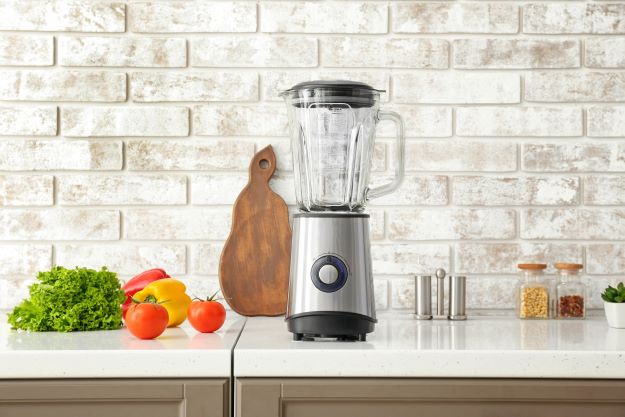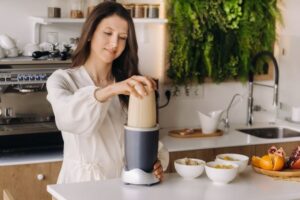
How to make cotton candy with a blender
- Shamima
- April 17, 2023
- 9:52 am
- No Comments
Do you go to festivals or carnivals and get hair-like snacks in the spirit of festivities? The moment you taste it, there is no going back. Once you know the name to be cotton candy, you begin to want to know how to make cotton candy with a blender. You surf the net, and luckily, you find this article. Without a doubt, we will unravel the myth behind this delicious food.
Literarily, a “Cotton look” and a “candy food” equal Cotton candy. Cotton candy derives its name from its yummy, irresistible, and salivating look. It has a variety of designations in different cultures and countries. Its facial look has a ninety-nine (99) percent involvement in its naming. It is candy floss (Ireland, UK) or fairy floss (Australia, New Zealand). In India, you can hear it called “Grandma’s hair.” Similarly, In the UAE and Saudi Arabia, cotton candy is “girl’s hair.” In addition, Egyptians refer to it as “Girl’s Yarn.”
Previously, cotton candy machines are commonly used to create this treat. Nowadays, it is possible to make cotton candy at home with a personal blender. This article will explore how to make cotton candy with a blender. As a bonus, the necessary ingredients, a step-by-step process, and tips. All in the bid to make your cotton candy yummier.

What is cotton candy?
Cotton candy is a confectionary treat made from spun sugar. This sugary treat is a result of spinning sugar at high speeds. This causes the sugar to melt and form tiny threads. Finally, the following line of action is placing the hair-like strands on a cone. This creates a fluffy and airy confection. They could also be in a soft, velvety ball shape that resembles cotton and packed in a plastic bag.
The candy comes in various colors and flavors. Examples are pink vanilla, blue raspberry, and green apple. It is a popular treat at carnivals, fairs, and other outdoor events. However, Using a cotton candy machine or any affordable blender, you can home-make it.
Cotton candy got some respect in the US. It has “December 7” dedicated to it as National Cotton Candy Day. With that, people of all ages and races have derived some enjoyment from it. Also, you might wonder how those tiny strands of hair stood. Still, I bet you are not in the wonderland alone, and we are about to unravel the mystery behind it below.
Science of cotton candy – how perfectly do cotton candies come alive?
The science behind cotton candy premises on the unique properties of sugar. This also includes the way it behaves under specific conditions. Melted sugar transforms into cotton candy when subjected to high speeds. This stretches the sugar into fine strands. The strands cool and solidify as they meet the air. This creates the fluffy, cotton-like texture that gives cotton candy its name. In creating a perfect cotton candy, several factors must be carefully controlled:
Temperature: The sugar must heat to a high temperature of around 320-350°F (160-177°C). If the temperature is too low, the sugar will not melt properly and will not spin into fine threads. Likewise, the sugar can burn and turn brown if the temperature is too high. This thereby affects the cotton candy’s taste and texture.
Spinning speed: You must control the spinning speed of the cotton candy machine. This is to ensure that the sugar threads are thin and even. If the spinning speed is too slow, the strands will be thicker and clump together. Consequently, this results in dense and lumpy cotton candy. The threads will be too thin and delicate if the spinning speed is too high. This will make it difficult to form a cohesive cotton candy cone.
Humidity: The air’s humidity can affect how cotton candy forms. The sugar threads may become brittle and break apart if the air is too dry. This results in less fluffy cotton candy. The sugar threads may absorb moisture and become sticky if the air is too humid. Consequently, making it difficult to form the cotton candy into a cohesive shape.
Color and flavor: The sugar mixture’s color and taste must be carefully chosen. Also, its controlled measurement helps to create perfect cotton candy. The sugar should be a bright and vibrant color. Similarly, the flavor should be strong enough to be noticeable but not overpowering.
Is it possible to make homemade cotton candy without a cotton candy machine?
Cotton candy machines are commonly used to make cotton candy. However, it is possible to make cotton candy at home with a blender. So, cheer up. You don’t need a high budget to treat yourself like a royal. You only need vital ingredients and essential kitchen tools.
A popular method to make cotton candy at home is using a high-speed blender. The blender spins the sugar mixture rapidly until it forms thin, string-like threads. These threads resemble the fluffy texture of traditional cotton candy. This process requires heating the sugar mixture to a high temperature. After that, you then blend it in a high-speed blender. With that achieved, you spin the mix with a whisk or fork to create the desired texture.
The least used method is a heat source. Examples of these are stovetops or hot plates. They help to melt the sugar mixture. Immediately, spinning with a whisk comes in as it cools to create the cotton candy texture.
Both methods require careful attention and safety precautions. This is because working with hot sugar can be dangerous. Use protective gloves to handle the hot sugar mixture. This is important to avoid burns or injury.
Conclusively, homemade cotton candy differs in texture from a machine’s. However, it can still be a fun and tasty treat for friends and family.
What is the ingredients used for making cotton candy?
For ages, Morrison and Wharton specifically built the machine to handle cotton candy. However, we must admit that times have changed. As a matter of fact, technology is making the world much more effortless. You can now make cotton candy at home. Trust us, Homemade cotton candy is a breakthrough from the commercials. In making cotton candy with a blender, you will need the following ingredients:
Granulated sugar/ honey: This is the main ingredient for making cotton candy. You will need about a cup of Granulated sugar. However, we cannot rigidly ascertain the honey measurement per batch. This is because honey has a lower melting point and a different texture.
Corn syrup: You add corn syrup to the sugar mixture. This prevents it from crystallizing during heating. You will need about one tablespoon of corn syrup for each batch of cotton candy.
Water: Adding to the sugar mixture helps dissolve the sugar and corn syrup. Thus, you will need about ¼ cup of water for each batch of cotton candy.
Food coloring: Food coloring helps to add color to cotton candy. You can use any color, but most prefer pink, blue, or purple.
Flavoring extract (optional): Flavoring extract adds flavor to the cotton candy. You can use any flavor, such as vanilla, strawberry, or raspberry. This ingredient is optional but can add a nice touch to your cotton candy.
These ingredients are inexpensive and can be easily found in any grocery store. You can make delicious DIY cotton candy at home using a glass blender with these ingredients.
Step by step process of making cotton candy
You might have seen candy machines making cotton candy at stalls. You can also make them with commercial blenders. However, they are usually consumed on the spot. This is because they are weather-dependent food. You could wonder, “Can you make cotton candy at home?”. Yes, and it’s easier than you might think. Do you want to learn about DIY Cotton candy? Here is a blender starting guide / blender User guide on making cotton candy at home with a blender:
Step 1: Prepare the Sugar Mixture
Combine 1 cup of granulated sugar, one tablespoon of corn syrup, and 1/4 cup of water in a small saucepan. Stir the mixture over medium heat until the sugar dissolves. Then, increase the heat and bring the mixture to a boil at a temperature of 320°F (160°C).
Step 2: Cool the Sugar Mixture
Once the sugar mixture has boiled, remove the saucepan from the heat. Let it cool at a temperature of around 200°F (93°C). The sugar mixture is still hot at this temperature but is cool enough to handle.
Step 3: Blend the Sugar Mixture
Pour the cooled sugar mixture into a high-speed blender. Cover the blender with a towel to prevent hot sugar from escaping. Afterward, blend the mixture quickly for 1-2 minutes. Hold the towel securely, as the sugar mixture will be very hot and may escape.
Step 4: Spin the Cotton Candy
Carefully pour the sugar mixture into a large mixing bowl once it blends. Using a whisk or fork, spin the sugar mixture rapidly in a circular motion. Ensure the cotton candy forms thin, string-like threads.
Step 5: Gather the Cotton Candy
Gather the cotton candy threads and wrap them around the cone or fork to form a fluffy ball. Spin a fork gently so the cotton candy does not stick.
Step 6: Process on Repeat
Repeat the process until you have made as much cotton candy as desired. You may need blender cleaning services and whisking between batches to prevent sticking.
Step 7: Serve and Enjoy
Once you have made your cotton candy, you can serve it on a stick or in a plastic bag. Enjoy your homemade cotton candy with family and friends!
In conclusion, making cotton candy with a blender requires patience and practice. Still, it can be a fun and rewarding experience. Follow the instructions and take precautions to avoid burns or injury. They may result from the hot sugar mixture.
Natural sweeteners like honey better in cotton candy?
Sugar is the primary ingredient used to make cotton candy. However, you can use natural sweeteners like honey as well. Honey is healthier because of its low glycemic index. Also, it contains more vitamins and minerals than sugar.
Honey has antimicrobial properties that can help fight bacteria and other harmful microorganisms. When used in cotton candy, it can provide a unique flavor and added health benefits. Honey cotton candies are healthy cotton candies.
Tips to make your cotton candy yummier.
As earlier stated, cotton candy is a sweet which, when tasted, there is no going back. Here are some tips to make your cotton candy yummier:
Use high-quality ingredients to create smoother and tastier cotton candy.
Add flavor extracts to the sugar mixture to create unique and delicious flavors.
Try different colors of food coloring to create visually appealing cotton candy.
Use a fork or a cotton candy cone to collect the threads as they form and roll them onto a cone for the perfect texture.
Nutrition and health benefits of cotton candy.
Cotton candy is a sugary treat not typically associated with being healthy. Consuming cotton candy in moderation is important. Also, it is crucial to be mindful of the nutritional value of the ingredients used to make it. However, cotton candy does have some health benefits:
Cotton candy consists of a significant amount of sugar. This is a carbohydrate that provides energy to the body. Consuming large amounts of sugar leads to weight gain and other health problems. However, moderate amounts can quickly boost energy.
Another potential health benefit of cotton candy is its ability to reduce stress. Eating sugary foods like cotton candy can trigger dopamine release in the brain. This improves mood and reduces feelings of stress and anxiety.
Common problems and their solutions.
Making cotton candy with a blender can be tricky. Over time, there are some practical problems that you may encounter in the process. We have also helped in suggesting possible solutions to these problems:
Problem: The sugar mixture is not spinning.
Solution: Ensure the sugar mixture has cooled enough before blending in the blender. If the mix is too hot, it will not spin correctly.
Problem: The sugar threads are not forming.
Solution: Make sure you use a high-speed blender and that the mixture is thick enough to form threads. If the mixture is too thin, undeniably, it will not create threads.
Problem: The cotton candy is too sticky.
Solution: Dust the cotton candy with cornstarch to prevent it from sticking together.
How to make cotton candy with a blender: Final thought
Making cotton candy with a blender is a fun and easy way to enjoy this classic treat at home. You can create fluffy and airy cotton candy in different colors and flavors. Just use essential kitchen tools and a few key ingredients. However, it is important to remember to consume cotton candy in moderation. Also, be aware of the nutritional value of the ingredients used to make it. You can also try our most recommended product Best Protein Shakes Blender.
Some Frequently Asked Questions
What other sweeteners can I use in my cotton candy?
Sanding sugar, honey, maple syrup, corn syrup, and stevia.
Can baking powder replace baking soda?
No. They are different and are not used interchangeably in recipes. Baking powder comprises baking soda, cream of tartar, and sometimes cornstarch. In contrast, baking soda is pure sodium bicarbonate.
What kinds of colors can I use?
Depends on what color you resonate with. Here are a few mixtures that could give some colors.
Red: Use red food coloring in a small amount for classic pink cotton candy.
Blue: Use a small amount of blue food coloring to create blue cotton candy.
Green: Mix yellow and blue food coloring to create green cotton candy.
Purple: Combine red and blue food coloring to make purple cotton candy.
Orange: Mix yellow and red food coloring to create orange cotton candy.
What health considerations should I remember?
Just like all sugar treats, you must consume them in moderation. If you have allergies to certain ingredients used, don’t consume them. Also, it has an impact on blood sugar levels and Dental health. Keep consumption low if you want to watch these health conditions.
Table of Contents
ToggleShamima
I am working in a restaurant. One of the responsibilities is to monitor the Kitchen Appliances’ performance and inform the maintenance department. Sometimes, I work closely with the maintenance team. I have gained some knowledge of kitchen appliances from there and want to share it with you. I have a passion for explaining my understanding simply.
DISCLAIMER
Ponnopick intends to provide guidelines other than advice. We help buyers better understand the product.
INCOME DISCLOSURE
We have used affiliate links in the articles, and we may earn a commission through successful purchases from that links.










